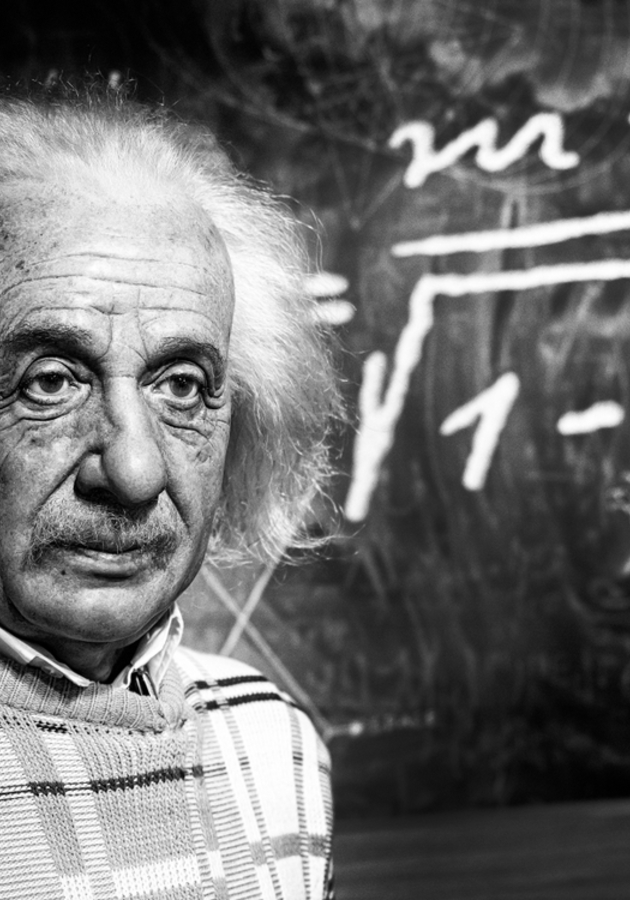In the year of 1905, between the beginning of June and the end of November, there appeared in the German scientific journal “Annalen der Physik” four papers by a single author which initiated a revolution in scientific thought and forever changed the way we see the world. The first one, though seemingly simple, resolved the then-unsolved puzzle of the photoelectric effect by suggesting that energy wasn’t continuous, but exchanged only in discrete amounts called quanta. The second one provided definite proof that atoms do indeed exist – a fact that had been in dispute at the time. The third and the fourth one quietly amalgamated space and time into one fundamental unity; convincingly demonstrated that energy and matter are two forms of the same thing; and effectively laid the foundations for nearly all of modern physics.
The name of the author of these four pieces was Albert Einstein. At the time, he was a 26-year-old bureaucrat working at the national patent office in Bern as a third-class technical examiner. He had neither university affiliation nor access to a laboratory – or even a substantial scientific library. His papers, written in a style unlike that of any other theoretical physicist, rather than references and quotes to authority, contained a good deal of verbal commentary and a few what-if experiments. “It looked,” wrote physical chemist C. P. Snow in 1967, “as though Einstein had reached the conclusions by pure thought, unaided, without listening to the opinions of others. Тo a surprisingly large extent, that is precisely what he had done.” But how did he do it? The answer to that question takes us all the way back to Einstein’s childhood and two seemingly everyday objects: a compass and a book.
“A deep sense of wonder”: Einstein’s childhood
Albert Einstein was born on March 14, 1879, in Ulm, in southern Germany, into a family of “entirely irreligious” Ashkenazi Jews. He grew up and obtained his early education in Munich. Little in his early life suggested the greatness to come. Famously, he didn't learn to speak until he was 3; moreover, he was unable to speak fluently even at the age of 9. That didn’t stop him from quietly contemplating the laws of nature, though. At the age of 5, he was overcome by a deep sense of wonder when his father showed him a compass for the first time. Seeing the needle behaving in such a determined way without being touched by anyone made him realize a profound truth about the world – namely, that “something deeply hidden had to be behind observable things.”
For the young Einstein, that something was initially the Jewish God. However, at the age of 12, through the reading of popular scientific books, he recognized that much in the stories of the Bible could not be true. “The consequence,” he would write much later in his “Autobiographical Notes,” “was a positively fanatic orgy of freethinking, coupled with the impression that youth is intentionally being deceived by the state through lies; it was a crushing impression. Suspicion against every kind of authority grew out of this experience, a skeptical attitude towards the convictions which were alive in any specific social environment” – an attitude which wouldn’t leave Einstein ever again, even though later on, “because of a better insight into the causal connections, it would lose some of its original poignancy.”
Just as he abandoned “the religious paradise of his youth,” Einstein was beginning to become aware of another, wholly different, world – a world which, in his own words, “exists independently of us human beings and which stands before us like a great, eternal riddle.” This world – he discovered wide-eyed at the age of 12 in a little book dealing with Euclidean plane geometry – obeyed some strange laws which, “though by no means evident, could nevertheless be proved with such certainty that any doubt appeared to be out of the question.” The book helped Einstein realize two important things. First of all, that imagination and reasoning arise when an experience comes into conflict with the world of concepts our parents and teachers have fixed in our brains; and secondly, that science is, essentially, an attempt to overcome such conflicts – or, rather, in Einstein’s succinct definition, “a continuous flight from wonder.”
Einstein’s adolescence and education
The little book dealing with Euclidean plane geometry which opened Einstein’s eyes to the beauty of mathematics was given to him by the family tutor. “He worked through the entire book in a single summer,” the tutor would remember later. “He thereupon devoted himself to higher mathematics. Soon the flight of his mathematical genius was so high I could not follow.” Indeed, by the age of 16, Einstein mastered algebra, geometry, and the principles of differential and integral calculus – mostly on his own. He also became interested in philosophy through Immanuel Kant’s “Critique of Pure Reason,” and in physics through Aaron David Bernstein’s multivolume work, “From the Field of Natural Science.” Especially the latter book, he read with “breathless attention.”
Despite his passion for science, Einstein resented school as a teenager, and frequently clashed with many of his teachers over their teaching methods. At the age of 16, he was expelled by one of them for the negative effects his rebellious attitude was having on the morale of his classmates. That same year, Einstein tried to enter the Federal Institute of Technology (FIT) in Zürich, Switzerland, but failed his college entrance exams on the first try. On the advice of the principal, he thereupon obtained his diploma at the Cantonal School in Aarau, and in 1896 he was automatically admitted to the FIT, on a four-year course designed to mass-produce high school science teachers. А bright but not outstanding student, he graduated in 1900, and spent the next two years in a frustrating but fruitless search for a teaching post.
Finally, with the help of a friend, Einstein secured a job in Bern at the Swiss Patent Office as an assistant examiner, level III. He was tasked with evaluating patent applications for a variety of devices, including a gravel sorter and an electromechanical typewriter. Even though seemingly unstimulating, Einstein enjoyed his job: it was challenging enough to engage his mind, but not so challenging as to distract him from his physics. He remained at the patent office for the following seven years. In the meantime, he completed his thesis on molecular dimensions, and began publishing scientific papers in the journal “Annalen der Physik.” His very first published paper, on the physics of fluids in drinking straws, appeared in the same issue of the journal as an epoch-making text titled “On the Law of Distribution of Energy in the Normal Spectrum.” The paper was written by German theoretical physicist Max Planck. It unveiled a strikingly novel way of thinking about energy.
The first paper of 1905: the law of the photoelectric effect
Five years before Einstein’s miraculous year of 1905, Planck wobbled the world of physics by positing that, at least algebraically, light energy could be better represented as a sum of individualized packets, rather than as a continuous wave. Planck’s assumption went defiantly against classical physical concepts, but was a purely mathematical construct. He was merely trying to improve an older statistical derivation, called the Rayleigh-Jeans formula, which could correctly predict the energy emitted by an ideal black body at all radioactive frequencies but those of the ultraviolet region of the electromagnetic spectrum. Planck, however, wasn’t happy with his formula, fully aware that quantization was incompatible with some of the basic postulates of classical electromagnetism. Always the conservative, he chose not to believe his own math, no matter how much it fit the empirical results for black-body radiation. Einstein, fortunately, took Planck’s assumption far more seriously.
In his first paper of 1905 – which he submitted to the “Annalen der Physik” just four days after his 26th birthday – he used Planck’s idea of light quanta to address a long-standing problem in physics called the photoelectric effect. This phenomenon had been discovered by German physicist Heinrich Hertz in 1887 and thoroughly investigated by Hungarian-born German Nobelist Philipp Lenard in 1902. The two demonstrated that metal electrodes could produce a flow of electricity (that is, emit electrons) when illuminated by certain wavelengths of radiation only, typically ultraviolet light. Seemingly innocuous, this observation presented a fundamental problem for classical electromagnetism, according to which intensity, and not frequency, was supposed to govern the amount of energy being delivered by a light beam. Yet, Hertz and Lenard showed that metal electrodes refused to emit electrons when illuminated by low-frequency beams, regardless of the intensity of the light source.
Because a low-frequency beam, even at a high intensity, could not build up enough energy to emit electrons, Einstein concluded that Planck’s mathematical trick was actually a genuine reflection of our reality. In his first paper of 1905, he proposed that beams of light weren’t waves propagating through space, but swarms of discrete energy packets, which we now refer to as photons. The photoelectric effect, he elucidated, occurred because electrons, rather than accumulating energy from continuous light waves, actually interact with photons on an individual basis. Furthermore, Einstein correctly supposed that the energy carried by each photon depends solely on its wavelength, and that this relation is inversely proportional: the shorter the wavelength, the higher the energy. Thus, it doesn’t matter how many photons bombard the surface of a metal electrode; what matters is if there is at least one photon which is of the right frequency.
Waves, particles and the origins of quantum theory
Einstein’s explanation for the photoelectric effect appears quite natural today, but it was an extremely bold prediction in 1905. So bold, in fact, that it was immediately rejected by leading figures of the day. Not until a decade later did American physicist Robert Millikan finally succeed in experimentally verifying it for ordinary light. In subsequent years, the experiments of French physicists Maurice de Broglie and Jean Thibaud confirmed Einstein’s equations for X-rays and gamma rays as well. When in 1921, Einstein was awarded the Nobel Prize in Physics, the explanation of the Stockholm Committee stated that it was to recognize “his discovery of the law of the photoelectric effect.” Even then, it wasn’t evident that far more revolutionary than Einstein’s dazzling equation of the effect was the premise he based it on – namely, the light quantum hypothesis.
About two centuries before Einstein, English mathematician Isaac Newton, the father of modern physics, elaborated upon Descartes’ assumption that light was made up of numerous small particles and presented the world with the so-called corpuscular theory of light. Dutch polymath Christiaan Huygens was quick to point out that Newton’s theory couldn’t properly explain some properties of light such as refraction, diffraction and interference and proposed that light doesn’t travel in streams of particles (like a series of baseballs being thrown in a straight line), but in waves (like sound and water). In the 19th century, Augustin-Jean Fresnel presented convincing arguments in favor of Huygens’ wave theory, and physicists decided that light must be a wave. That’s what convinced Planck that his light quanta were actually mathematical fiction. The wave theory could explain far more about the properties of light than Newton’s corpuscular theory.
Accordingly, despite substantiating his own calculations, Planck panicked after reading Einstein’s first paper of 1905, publicly remarking that if the scientific community were to accept Einstein’s iconoclastic hypothesis, “the theory of light would be thrown back not by decades, but by centuries, into the age when Christiaan Huygens dared to fight against the mighty emission theory of Isaac Newton.” Nevertheless, just a few years later, Einstein proved that his light quantum hypothesis didn’t only account for the photoelectric effect, but also for the anomalous low-temperature behavior of the specific heats of solids. Enough was enough for Planck, so, at the 1911 Solvay Conference, he conceded defeat and finally accepted the validity of Einstein’s theory. It is not an exaggeration to say that this was the moment that quantum theory was born.
The ether drift and the Michelson-Morley experiment
Even though, by 1911, Planck had become convinced that Einstein’s light quanta were, in fact, real physical particles, he wasn’t slow to spotlight that Huygens’ age-old arguments against their existence still stood: a purely corpuscular theory of light, he wrote, could not account for the phenomena of diffraction and coherence of light waves. Well, Einstein couldn’t agree more. Ultimately, the two arrived at the conclusion that light was somehow both a particle (photon) and a wave. The wave-particle duality of light highlighted the inability of macroscopic concepts such as “particle” or “wave” to describe the physical properties of nature at the scale of atoms and subatomic particles. In doing so, it gave birth to one of the two fundamental theories in physics: quantum mechanics. The other one, that of relativity, was devised by Einstein from scratch, in his last two papers of 1905. We’ll get to it in a minute. But first, allow us a slight detour to make the connection.
If the weakness of the quant theory of light was its inability to explain homogenic diffraction, the weakness of the wave theory was that light waves, just like sound waves, needed a medium for transmission. Waves are, after all, types of vibrations, and vibrations are not possible in empty space – they must occur in something. For this reason, in his “Treatise on Light,” Huygens accepted Newton’s earlier suggestion that there must exist some hypothetical substance permeating the entire universe through which light constantly moves. This substance was named “the luminiferous ether.” In the words of American-British popularizer of science Bill Bryson, it was “a stable, invisible, weightless, frictionless, and unfortunately wholly imaginary medium.” Unsurprisingly, despite figuring prominently in numerous equations, centuries of experiments couldn’t prove the existence of ether. And then, the Michelson–Morley experiment of 1887 convincingly disproved it, shaking the very foundations of physics.
You see, one of the expected consequences of the fixed ether theory was that the speed of light, as it pushed through the luminiferous ether, should vary with respect to an observer, depending on whether the observer was moving toward the source of light or away from it. However, nobody had figured out a way to measure this phenomenon, usually called “the ether drift.” In April 1881, it occurred to American physicists Albert Michelson and Edward Morley that for half the year, the Earth is moving away from the Sun and for the other half, it is travelling toward it. So, they realized that taking careful measurements at opposite seasons and comparing the light’s travel time between the two could be a great way to measure the “ether drift.”
Well, it turned out to be the best way to negate it. Michelson and Morley found no difference between their measurements. The speed of light turned out to be “the same in all directions and at all seasons,” as astrophysicist Kip S. Thorne wrote later. Overnight, the Michelson-Morley outcome became, in the words of historian of science William H. Cropper, “probably the most famous negative result in the history of physics.” How could it not? It was the first hint in two centuries that Newton’s laws might not apply all the time everywhere. Then what were the laws that did? Einstein had a groundbreaking idea.
The special theory of relativity
“If the Michelson–Morley experiment had not brought the science of physics into serious embarrassment,” wrote Einstein later in his life, “no one would have regarded the relativity theory as a (halfway) redemption.” Indeed, even though Einstein probably wasn’t even aware of its “null result” in 1905, his third paper of that year – titled, briefly, “On the Electrodynamics of Moving Bodies” – presented such a radical idea of the universe that it would have been met with ridicule at any time preceding the Michelson-Morley experiment. As a matter of fact, many physicists persisted in believing the existence of ether rather than Einstein’s math long after his theories were first published. “The ether is not a fantastic creation of the speculative philosopher,” remarked British Nobel Prize-winning physicist J. J. Thomson as late as 1909. “It is as essential to us as the air we breathe.”
Four years earlier, Einstein had, in fact, demonstrated the opposite. There was no ether, he argued, and light wasn’t just another type of vibration, but a special sort of wave which required no medium to carry it. Its speed, he proposed, was a universal constant, and must be taken as being the same in all frames of reference. Profoundly counterintuitive, this idea doesn’t match our everyday experience. Usually, we think of speed as relative to a frame of reference. For example, if you are travelling on a train at 10 miles per hour and you throw a ball at 5 miles per hour in the direction you are moving, the ball, relative to you, will be moving at 5 miles per hour. However, to a person on the ground observing you in the train, it will be moving at the train’s speed plus the speed at which you threw the ball – that is, 15 miles per hour. So, what’s the speed of the moving ball? Depends on who you ask.
What Einstein suggested was that the speed of light didn’t work in this way. No matter what the frame of reference, he argued, it always moved at the same speed – c, or approximately 186,000 miles per second. To illustrate, if you shine a flashlight at a friend from a distance while standing still, the beam of light will travel toward him at the same speed as it would if you shined that same flashlight while travelling toward your friend at a very high speed, say, on the train from before. You can’t just add the train’s velocity to the speed of the beam as in the case of the ball. Light travels at the same speed – at all times. Wherever you are, and whatever you’re doing, you’ll always measure the velocity of light as c. Nothing more, nothing less. That’s why the Michelson-Morley experiment gave the null result. As Einstein realized, that’s also why our universe was much more unusual than Newton could have ever guessed.
Strange implications of the special theory of relativity
Special relativity, as Einstein’s theory became later known, asked physicists to accept no more than two postulates – that light moves through a vacuum with a fixed speed independent of the motion of the source, and that the laws of physics should appear the same to observers in all inertial frames of reference. The consequences of accepting these two simple postulates weren’t just momentous, but mind-boggling as well. Speed, as you might remember from your physics classes, is the rate of change of distance with time. So, the faster you move, the more distance you cover in shorter spans of time. But if light travels at the same speed at all times, and the laws of physics appear the same to all observers, then it follows that there can be no absolute time or space! Put otherwise, to keep the speed of light constant at all times and in all frames of reference, space and time must become stretchy and variable – and, moreover, they must work together!
Now, that’s bizarre. Intuitively, it’s perfectly obvious that time cannot affect space and space cannot affect time. But let us go back to our train example and replace the ball with a torch. As we already explained, the speed of the moving ball would be different for the person on the train and the person standing on the station platform, because the latter one would have to add the forward speed of the train to the speed at which the ball is moving. However, if the person on the train were shining a light at the opposite wall and measured its speed, he and the person on the platform would both find that the photons had the same speed at all times – 186,000 miles per second. The only way this can happen is if the clock of the train observer is ticking at a slightly different rate than the clock of the person standing on the station platform. Somehow, the motion of the train must make time slow down.
The phenomenon we just described is called time dilation and is not only measurable, but experimentally proven as well: a moving clock actually ticks more slowly than a stationary one. As strange as this might sound, there’s even more to it. Say, our observer on the platform knows the speed of the moving train. Now say that he starts his stopwatch as the front of the train passes him by and stops it as the end of the train leaves him behind. Since distance is speed multiplied by time, the observer would be thus able to calculate the length of the train. But what about the train traveler? If his clock is ticking slower, wouldn’t that give him a shorter length? Indeed, it would! A person in a superfast train will not only measure time to be moving slower but also the lengths of objects to be shorter when compared with a person standing on a platform. This is called length contraction and is the second great consequence of special relativity.
The general theory of relativity
Time dilation and length contraction are actually interrelated phenomena. You can’t really separate the two. That’s because time and space are interrelated and mutually constrained as well. As Einstein’s former teacher Hermann Minkowski realized in 1908, to preserve an independent reality, the theory of relativity demanded that time be fused together with the three dimensions of space into a single four-dimensional continuum now known as spacetime. Minkowski’s geometric interpretation of relativity proved vital to Einstein’s development of his general theory of relativity, wherein he showed that spacetime becomes curved in the presence of mass or energy – and completely turned on its ear the universally accepted gravitational laws of Newton. If Einstein hadn’t thought of special relativity, eccentric English physicist Paul Dirac observed once, someone else would have within a few years. But the general theory is an entirely different matter. “Without it,” wrote C. P. Snow in 1979, “it is likely that we should still be waiting for the theory today.”
The special theory of relativity demonstrated that time and space aren’t absolute, but relative to both the observer and to the thing being observed. The reason why we, nevertheless, feel that time passes the same for everybody is that everything here on Earth moves at the tiniest fraction of the speed of light. Even our rockets and spaceships aren’t a great exception. For example, American astronaut Scott Kelly shaved only 13 milliseconds off his Earth age after spending an entire year travelling through space. If special relativity seems weird to you it’s because, at everyday speeds, its effects are much too small to make the tiniest detectable difference. However, for other things in the universe – such as light, gravity, and the universe itself – these are matters of consequence. That’s precisely what the general theory of relativity proposed to demonstrate.
In a paper published in 1917, titled “Cosmological Considerations on the General Theory of Relativity,” Einstein argued that, rather than as a force, gravity was much better thought of as the warping of the spacetime continuum by objects pushing through it. To understand this better, picture spacetime as something flat but pliant, say a mattress or a sheet of stretched rubber. Now imagine putting a heavy round object on it, such as a bowling ball. The weight of the bowling ball would, of course, cause the sheet to stretch and sag slightly. Well, precisely the same happens out there in the universe. The Sun, being a large round object, stretches and curves and warps the fabric of spacetime. In other words, it has the same effect on its invisible surroundings as the bowling ball has on the visible sheet in our experiment.
Now let’s go back to the sheet itself, as we left it, slightly sagged by the bowling ball. Ask yourself what would happen if you rolled a smaller ball across it, say, a glass marble? The answer is, it would try to go in a straight line as required by Newton's laws of motion, but as it nears the bowling ball and the slope of the sagging fabric, it would roll downward, inescapably drawn to the more massive object. Find a way to abolish friction and the glass marble will start orbiting around the bowling ball, traveling along the geodesics of the curved surface. That’s gravity for you – not a force, but a byproduct of the bending of spacetime. In other words, it’s not gravitational forces that move the planets of our Solar system. Instead, the Sun is a bowling ball that has curved spacetime, and the Earth and the other planets marbles that travel along different geodesics produced by this curvature.
E=MC^2: the world’s most famous equation
Another radical finding Einstein made in 1905 was the equivalence of energy and mass. Combined with a few other laws of physics, the two postulates of his theory of special relativity predicted that mass and energy must be related by what is certainly the world’s most famous equation: E=MC^2. The equation originally appeared in the last of Einstein’s four papers of 1905, a fascinating two-page article titled, “Does the Inertia of a Body Depend Upon Its Energy Content?” In it, as the equation shows, Einstein argued that energy and mass (matter) are interchangeable, that is to say, that they are two different forms of the same thing. To put it in the words of Bill Bryson, energy is nothing other than liberated matter; matter, on the other hand, is energy waiting to happen. Meaning, under the right conditions, energy can become matter, and vice versa.
Once again, this bears no resemblance to the way we, humans, perceive things intuitively. For us, a beam of light is something entirely different from, say, a paper clip or an average-sized adult. Yet, Nature sees all three as different forms of the same thing. You can as well. Just think of a uranium bomb. Isn’t that a good example of matter being turned into energy in an instant? Einstein’s equation merely adds that everything else which has mass can be turned into energy as well – including yourself. If you are an average-sized adult and we have efficient ways to turn your entire mass into energy, you will explode with the force of 30 very large hydrogen bombs. Since c2 is a really enormous number, even a tiny paper clip would produce a devastating explosion. Indeed, if you could turn every one of its atoms into pure energy – leaving no mass whatsoever – the paper clip would yield 18 kilotons of TNT, or roughly the size of the bomb that destroyed Hiroshima in 1945.
For better or for worse, we’re not very good at getting a lot of energy out of matter here on Earth. Even a uranium bomb, the most energetic thing we have produced yet, releases less than 1% of its potential energy. Turning a paper clip or a human being into an explosive would require temperatures and pressures greater than those at the core of our Sun. But that’s beside the point. What’s not is that Einstein’s equations suggest that the relativistic mass of an object must increase as its velocity does. A baseball gets slightly heavier when you throw it. The faster you can do this, the heavier the baseball gets. Using Einstein’s equation, we can calculate that when a pitcher throws a baseball at 100 miles an hour, the baseball gets heavier by 0.2 billionths of a gram.
That’s not much, of course. But consider what would happen if some immensely powerful alien could throw the baseball at an appreciable fraction of the speed of light, say 90%. Einstein’s equation says that the baseball will inevitably absorb this excessive amount of kinetic energy as inertial mass and weigh about twice as much as it might have at rest at the time of throwing. But consequently, it would become twice more difficult to throw it. The more energy you put into the throw, the heavier the baseball gets, so the more energy you would need to speed it up. What’s the maximum speed at which our made-up alien would be able to throw the baseball before it becomes too heavy to accelerate further? The speed of light, of course. At or near light speed, any extra energy you put into an object does not make it move faster but just increases its mass. That’s why nothing can travel faster than light. It is the speed limit of the universe.
From academic recognition to worldwide stardom
Although Einstein’s papers of 1905 seemed too obscure at first to make much impression beyond the esoteric world of physics, they propelled him to fame within that community. In 1909, he was appointed associate professor at the University of Zürich, and four years later he became a full professor of theoretical physics at his alma mater. Just before World War I began, Max Planck and another future Nobelist, chemist Walther Nernst, visited Einstein in Zürich to persuade him to accept a lucrative research professorship at the University of Berlin, along with full membership in the Prussian Academy of Science. After a brief period of consideration, Einstein accepted the offer, famously quipping on the occasion: “The Germans are gambling on me as they would on a prize hen. I do not really know myself whether I shall ever really lay another egg.”
Einstein’s decision to move to Berlin was at least partially influenced by the prospect of living near his second cousin Elsa, with whom he was having a romantic affair at the time, despite being married to Serbian physicist Mileva Marić. With Marić, Einstein had three children: two sons, Hans Albert and Eduard, and a daughter, the whereabouts of whom remain unknown to this day. Conceived out of wedlock while Einstein and Marić were still students at the Zürich Polytechnic, the girl – who was given the name of Lieserl at birth – was probably discreetly put up for adoption and either died at an early age from scarlet fever or was raised under a wholly different name somewhere in Novi Sad, in what was then Yugoslavia. Either way, at the time Einstein left Zürich for Berlin, he and Marić weren’t on speaking terms. They divorced on February 14, 1919. Three and a half months later, on June 2, 1919, Einstein married Elsa.
Just three days before that, English astronomer Arthur Eddington, then-Secretary of the Royal Astronomical Society, set sail for the island of Principe, off the coast of West Africa, in order to observe the solar eclipse of May 29, 1919. Einstein had predicted, in his theory of general relativity, that a total solar eclipse would make measurable the deflection, or bending, of light caused by the Sun’s gravity. On November 6 of the same year, the results of Eddington’s expedition were announced in London at a joint meeting of the Royal Society and the Royal Astronomical Society. They fitted Einstein’s predictions perfectly. The headline of The Times of London read, “Revolution in Science—New Theory of the Universe—Newton’s Ideas Overthrown—Momentous Pronouncement—Space ‘Warped.’” Up until then known to professional physicists only, Einstein was suddenly propelled to global fame. Almost overnight, he became a world-renowned scientist, the worthy 20th-century successor to Isaac Newton.
A matter of life and death
If November 1919 was the month that made Einstein – Einstein, the decade that followed was the one that etched him into the collective memory of humanity. With Eddington’s proof, invitations for him to speak around the world came pouring in. In 1921, he embarked on the first of several world tours, visiting the United States, England, Japan, and France. Coming back from Japan to Europe, he received word that he had won the Nobel Prize for Physics for his work on the photoelectric effect. During his acceptance speech in Stockholm, Einstein startled the audience by barely mentioning the photoelectric effect. Instead, he chose to speak about his theory of relativity. Unlike the Nobel Committee or his audience, he knew full well what his main contribution to science and human progress was.
Inevitably, though, Einstein’s fame created a backlash in his adopted country of Germany. The rising Nazi movement began enlisting physicists, including Nobel laureates Philipp Lenard and Johannes Stark, to denounce Einstein’s work. In 1931, a collection of various criticisms of his theories was published under the title “A Hundred Authors Against Einstein.” When asked to comment on the book Einstein replied that if relativity was wrong, one wouldn’t need the word of 100 scientists – they would need just one simple fact. Unfortunately, when they couldn’t find such fact, Nazi scientists began their ad hominem attacks on Einstein, derogatively branding him “a Jew” and calling his theories – “Jewish physics.” As time went by, the callousness increased until one day, a Nazi organization published a magazine with Einstein’s picture and the caption “Not Yet Hanged” on the cover. Things had become a matter of life and death. It was time to leave Berlin.
In 1933, Einstein resigned from the Prussian Academy of Science and, after spending some time in Belgium, covertly emigrated to the United States. Because most American private universities at the time had rigid Jewish quotas in place, Einstein took up a position at the independent Institute for Advanced Study in Princeton, pretty much the sole intellectual refuge on American soil for Jewish scientists fleeing Nazi Germany. Einstein’s affiliation with the Institute lasted until his death two decades later. There, he developed a close friendship with logician Kurt Gödel, and spent countless hours trying to unify all laws of physics into one all-embracing framework. Obsessed with this idea, Einstein grew increasingly detached from his colleagues. Rather than accepting the quantum theory he helped create (and everybody worked on at the time), he tried finding logical inconsistencies in it. Just as he began to change his mind, he died of an aortic aneurysm, on April 18, 1955, at the age of 76.
The political beliefs of Albert Einstein
“The passing of Albert Einstein,” American educator Paul Arthur Schilpp wrote in 1969, “was an irreplaceable loss to science, to scholarship, to humanitarianism, to the cause of peace, and to the conscience of humankind. For, if the conscience of humanity could ever be said to have been represented by one single living human being, that human being was the great and truly immortal Einstein.” Indeed, Einstein was more than just a brilliant scientist – he was also a complex and well-respected intellectual who didn’t hesitate in using his fame to advance the causes he believed in. “It never occurred to me that every casual remark of mine would be snatched up and recorded,” he told one of his biographers. “Otherwise, I would have crept further into my shell.” Once he emerged from it, however, he became a powerful activist for his deeply held political beliefs.
He was, above all, an unwavering humanitarian. He believed in – and advocated for – a world in which there was equal opportunity to all regardless of race, gender, and social status. Accordingly, he supported the Civil Rights Movement, and used his fame to condemn American discrimination. “There is,” he said in a 1946 commencement address at Lincoln University, “a somber point in the social outlook of Americans: their sense of equality and human dignity is mainly limited to men of white skins.” A dedicated internationalist and lasting pacifist, Einstein promoted the creation of the United Nations and advocated reforming it once it had been created. He was also a firm supporter of world federalism and world law. Believing that capitalism encourages selfishness and leads to “an oligarchy of private capital,” Einstein was politically in favor of democratic socialism – a fact he made publicly known in May 1949 in an essay titled “Why Socialism?”
It was due to Einstein’s pacifism and his leftist views that he was never asked to participate in the Manhattan Project, which notoriously produced the first atomic bomb. When he learned that his celebrated equation E=mc2 was finally validated in the most terrifying way in Hiroshima, Einstein was deeply distressed; for a long time, he could only utter, ‘‘Horrible, horrible.’’ His shock owed a lot more to the fact that he was the main signatory of Leó Szilárd’s 1939 letter to President Franklin D. Roosevelt which urged the United States to commence a research program into the feasibility of nuclear weapons. “Had I known that the Germans would not succeed in developing an atomic bomb,” Einstein told Newsweek magazine in 1947, “I would have done nothing.” Later, he did everything he could to stop nuclear testing and future bombs. In fact, one of the last things he did, Just days before his death, was signing the Russell-Einstein Manifesto against nuclear proliferation.
The credos and legacy of Albert Einstein
Unsurprisingly, Einstein’s pacifist and leftist views didn’t go unnoticed in the United States. J. Edgar Hoover, the first director of the Federal Bureau of Investigation (FBI), accused him of being pro-Soviet and went so far as to recommend that Einstein be kept out of America by the Alien Exclusion Act. Fortunately, he was overruled by the U.S. State Department. Nevertheless, Einstein was one of the many prominent personalities the FBI spied on during the Cold War. Spanning almost 2,000 pages, his recently declassified file reveals that the FBI steadfastly monitored Einstein’s phone calls, illegally checked his mail and dedicatedly compiled a detailed record of his political views and activities for the purpose of criminalizing them. It is not known whether Einstein knew anything about the FBI’s clandestine activities, but it is a fact that he didn’t allow speculations about them to influence his views or change his actions. He was, as he wrote in one letter, prepared to go to jail for them.
Simply put, Einstein was always beyond earthly matters. Though not religious in the ordinary sense, he believed in the God of the 17th-century Dutch Jewish philosopher Benedict de Spinoza – the God of Beauty. He once stated this explicitly: “I believe in Spinoza’s God who reveals himself in the harmony of all Being, not in a God who concerns himself with the fate and actions of men.” This credo seems fully consistent with Einstein’s statement that the “less knowledge a scholar possesses, the farther he feels from God. But the greater his knowledge, the nearer is his approach to God.” In this regard, Einstein wasn’t far from the views of Ancient Greek philosopher Socrates who believed that knowledge was virtue in itself and that the unexamined life was not worth living. On one occasion, Einstein augmented Socrates’ famous aphorism, saying, “The only life worth living is a life spent in the service of others.”
Both through his services to science and his love for the less fortunate, that’s precisely the life Einstein lived. In doing so, he changed the way we think about everything. “The first half of the twentieth century,” wrote Louis de Broglie, “was marked by an extraordinary impetus to physics which will remain one of the most brilliant chapters in the history of science. In these few years, human science raised two monuments which will stand in future centuries: the theory of relativity and the quantum theory. The first emerged wholly from the creative brain of Albert Einstein. The second, whose first stones were laid by Planck, owes to the mind of Einstein some of its most noteworthy advances. One could not contemplate a work at once so profound and so powerfully original, accomplished in a few years, without astonishment and admiration. The name of Albert Einstein will be forever joined to two of the most magnificent achievements in which the human mind may take pride.”
Sources
Main
- Albert Einstein, “Autobiographical Notes,” in: Albert Einstein: Philosopher-Scientist (New York: MJF Books, 1970), 3rd edn, pp. 1-94 (bilingual).
- Louis de Broglie, “A General Survey of the Scientific Work of Albert Einstein,” in: Albert Einstein: Philosopher-Scientist (New York: MJF Books, 1970), 3rd edn, pp. 109-127.
- Michio Kaku, “Albert Einstein,” Encyclopedia Britannica (May 28, 2021). [https://www.britannica.com/biography/Albert-Einstein].
- Bill Bryson, “Einstein’s Universe,” in: A Short History of Nearly Everything (New York: Broadway Books, 2003), pp. 115-133.
- “Albert Einstein,” in: Encyclopedia of World Biography, Vol. V [Paula K. Byers, Suzanne M. Bourgoin, and Neil E. Walker eds.], 2nd edn (Gale, 1998), pp. 228-231.
- C. P. Snow, The Physicists (New London: House of Stratus, 1979).
- Bertrand Russell, The ABC of Relativity (London: Routledge, 2009).
Other
- Nicolas Michaud, “Special Relativity,” 1001 Ideas That Changed the Way We Think [Robert Arp ed.] (London, Cassell Illustrated, 2013), p. 623.
- Barry Stone, “General Relativity,” 1001 Ideas That Changed the Way We Think [Robert Arp ed.] (London, Cassell Illustrated, 2013), p. 647.
- “Albert Einstein: Gravity Is a Distortion in the Space-Time Continuum,” The Science Book (New York: DK, 2014), pp. 214-221.
- “Frequently Asked Questions,” Swiss Federal Institute of Intellectual Property (IGE), [https://www.ige.ch/en/about-us/the-history-of-the-ipi/einstein/faq]
- “The Nobel Prize in Physics 1921,” NobelPrize.org. Nobel Prize Outreach AB 2021. [https://www.nobelprize.org/prizes/physics/1921/summary/]
- Mack Levine, “Double-Slit Science: How Light Can Be Both a Particle and a Wave,” Scientific American (December 12, 2013). [https://www.scientificamerican.com/article/bring-science-home-light-wave-particle/]
- Michael Richmond, “The surprising results of the Michelson-Morley experiment,” Rochester Institute of Technology. [http://spiff.rit.edu/classes/phys150/lectures/mm_results/mm_results.html]
- Adam Mann, “What is space-time?” Live Science (May 20, 2021). [https://www.livescience.com/space-time.html]
- James Overduin, “Einstein’s Spacetime,” Stanford University (November 2007). [https://einstein.stanford.edu/SPACETIME/spacetime2.html]
- Roger Rassool, “Why can’t anything travel faster than light?” Cosmos (January 5, 2015). [https://cosmosmagazine.com/physics/why-can-t-anything-travel-faster-light/]
- W. Daniel Hillis, “Special Relativity: Why Can’t You Go Faster Than Light?” Edge.org (January 24, 1999). [https://www.edge.org/conversation/w_daniel_hillis-special-relativity-why-cant-you-go-faster-than-light]
- Alok Jha, “Why you can't travel at the speed of light,” The Guardian (January 12, 2014). [https://www.theguardian.com/science/2014/jan/12/einstein-theory-of-relativity-speed-of-light]
- Alok Jha, “Letters reveal relative truth of Einstein's family life,” The Guardian (July 11, 2006). [https://www.theguardian.com/science/2006/jul/11/internationalnews]
- Andrew Anthony, “Scott Kelly: ‘I came back from space younger than my twin,’” The Guardian (October 29, 2017). [https://www.theguardian.com/science/2017/oct/29/scott-kelly-astronaut-interview-space-younger-twin-endurance]
- “E=mc2 Explained,” Nova (August 2005). [https://www.pbs.org/wgbh/nova/einstein/lrk-hand-emc2expl.html]
- Dan Falk, “One Hundred Years Ago, Einstein’s Theory of General Relativity Baffled the Press and the Public,” Smithsonian Magazine (November 4, 2019). [https://www.smithsonianmag.com/science-nature/one-hundred-years-ago-einsteins-theory-relativity-baffled-press-public-180973427/]
- “Einstein's Deeply Held Political Beliefs,” American Museum of Natural History (February 28, 2003) [https://www.amnh.org/exhibitions/einstein/global-citizen]
- “The Manhattan Project,” American Museum of Natural History (February 28, 2003) [https://www.amnh.org/exhibitions/einstein/peace-and-war/the-manhattan-project]
- Alan White and Peter Daniels, “The FBI and Albert Einstein,” wsws.org (September 3, 2002). [https://www.wsws.org/en/articles/2002/09/eins-s03.html]





























